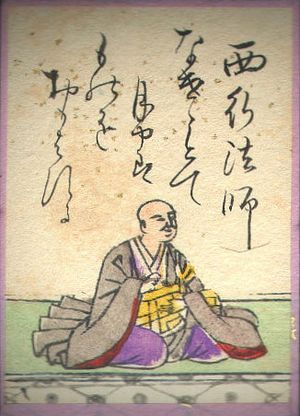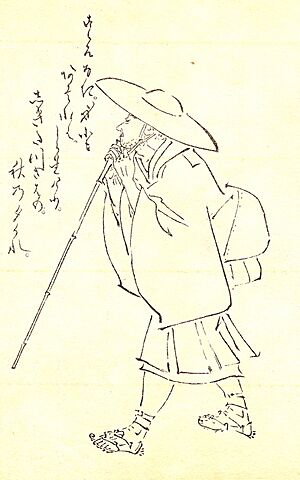Saigyō facts for kids
Quick facts for kids
Saigyō Hōshi (西行法師)
|
|
|---|---|

Saigyō Hōshi in the Hyakunin Isshu
|
|
| Born | Satō Norikiyo (佐藤義清) 1118 Kyoto, Japan |
| Died | 1190 (aged 71–72) |
| Pen name | Saigyō |
| Occupation | Poet |
Saigyō Hōshi (born 1118, died March 23, 1190) was a very famous poet from Japan. He lived during a time when Japan was changing a lot. This was from the late Heian period to the early Kamakura period.
Contents
About Saigyō's Life
Saigyō Hōshi was born in Kyoto with the name Satō Norikiyo. His family was noble, meaning they were important people. He lived when power in Japan was shifting. The old court nobles were losing power to new samurai warriors.
During his life, people believed that Buddhism was becoming weaker. They thought it was not as good for finding salvation anymore. These big changes made Saigyō feel a bit sad or thoughtful, which you can see in his poems.
When he was young, he worked as a guard for the retired Emperor Toba. But in 1140, when he was 22, he decided to leave his old life. He became a Buddhist monk and took the name En'i. We don't know exactly why he made this big change.
Later, he chose the pen name Saigyō. This name means "Western Journey." It refers to the Western paradise in Buddhism, where Amida Buddha lives.
Saigyō often lived alone for long periods. He stayed in places like Saga, Mount Kōya, Mount Yoshino, and Ise. He is also famous for the many long trips he took. He traveled to Northern Honshū. These journeys later inspired another famous poet, Bashō. Bashō wrote about his own travels in a book called Narrow Road to the Interior.
Saigyō was also a good friend of Fujiwara no Teika, who was another important poet.
Saigyō had his own collection of poems called Sankashū. This name means "Collection of a Mountain Home." Other famous collections also include his poems, like the Shin Kokin Wakashū and the Shika Wakashū.
He died at Hirokawa Temple in Kawachi Province. This area is now part of Osaka Prefecture. He was 72 years old.
Saigyō's Poetry Style
During Saigyō's time, the Man'yōshū was not as important for waka poetry. The Kokin Wakashū was more influential. The Kokin Wakashū focused on personal feelings and clever wordplay. It used elegant language.
However, Saigyō and other poets of his time wrote in a new style. Their poems were collected in the Shin Kokin Wakashū. This new style was less about personal feelings. It used more nouns and fewer verbs. It was not as interested in wordplay and sometimes repeated words. The flow of the poems could have breaks, and the language was a bit more like everyday talk. These poems often felt more serious and thoughtful.
Because of the difficult times he lived in, Saigyō's poems often explored deep feelings. He wrote about mono no aware, which is a gentle sadness about things changing. He also wrote about sabi, which means loneliness. And he wrote about kanashi, which is deep sadness. Even though he was a Buddhist monk, Saigyō still loved the world. He especially loved the beauty of nature.
Examples of His Poems

Many of Saigyō's most famous poems show a struggle. He was a monk, so he wanted to give up worldly desires. But he also deeply loved the beauty of nature. Most monks hoped to die facing West. This was so they could be welcomed by the Buddha. But Saigyō found the Buddha's presence in the beauty of flowers.
| Japanese | Rōmaji | Translation |
|
願はくは |
Negawaku wa |
Let me die in spring |
Being "heartless" was an important idea for Buddhist monks. It meant they had given up all desires and attachments.
| Japanese | Rōmaji | Translation |
|
心無き |
Kokoro naki |
Even a person |
Saigyō traveled a lot, but one of his favorite places was Mount Yoshino. This mountain is famous for its beautiful cherry blossoms.
| Japanese | Rōmaji | Translation |
|
吉野山 |
Yoshino-yama |
I'll forget the trail I marked out |
Saigyō's Lasting Influence
- Saigyō's travels and writings inspired other people. One example is Lady Nijō, a court lady. She wrote in her book Towazugatari that she dreamed of writing a travel book like Saigyō's. She had read his work when she was only 8 years old. Lady Nijō later became a Buddhist nun herself. She visited many of the same places Saigyō wrote about.
- Bashō, another very famous Japanese poet, also looked to Saigyō for ideas. For instance, Bashō once quoted Saigyō's poem about a pine tree. He then wrote that trying to write another poem about that same tree would be like "trying to add a sixth finger to his hand." This shows how much he respected Saigyō's work.
See also
 In Spanish: Saigyō para niños
In Spanish: Saigyō para niños

